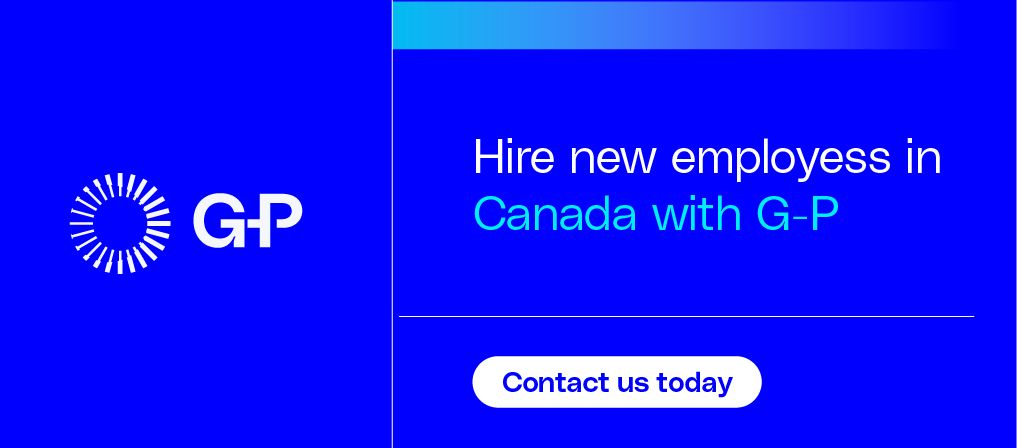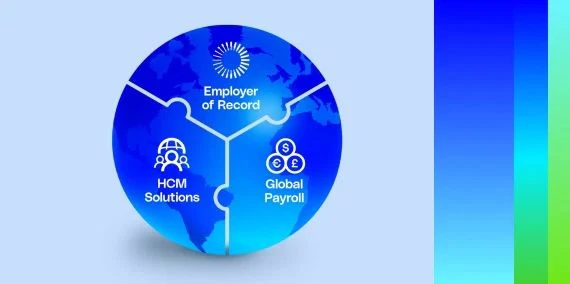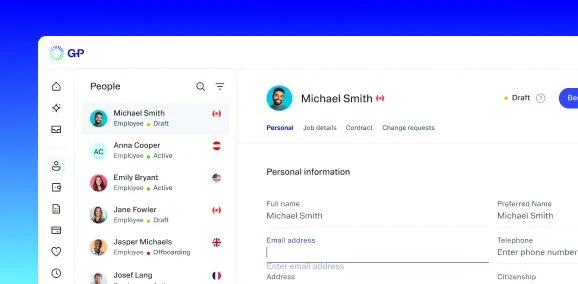Canada is a highly developed and open market economy. It offers access to North American and global markets through various trade agreements, such as the United States-Mexico-Canada Agreement (USMCA).
Canada is larger than the European Union combined and is home to approximately 40 million people. You’ll have no problem finding qualified workers in Canada, particularly in sectors like ICT, engineering, oil, and gas. Our guide will tell you everything you need to know about hiring employees in Canada.
What to know before hiring in Canada
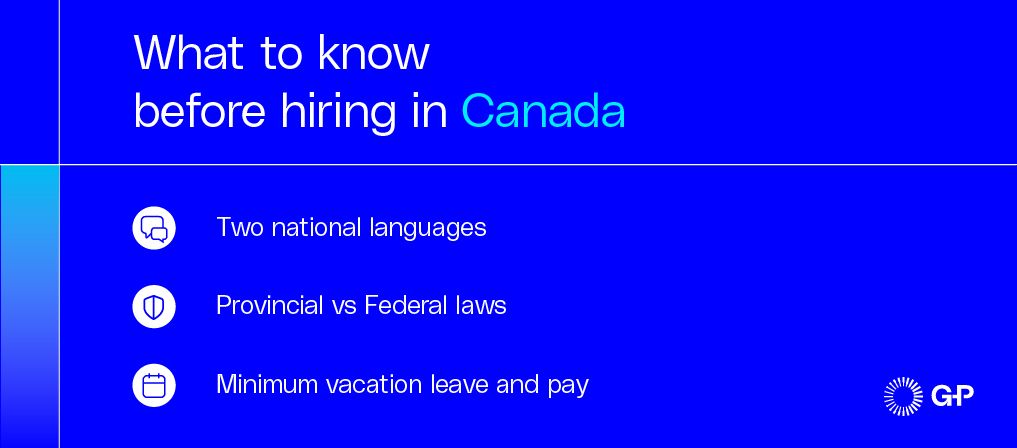
If you’re expanding your business into Canada for the first time, there are important legal requirements to be aware of. These norms and laws influence hiring practices in Canada and many aspects of the employer-employee relationship.
If you’re unsure where to begin, G-P Gia™, our AI-powered global HR agent, can answer your toughest compliance questions across 50 countries — including Canada — and all 50 U.S. states. Reduce your reliance on outside counsel and cut the time and cost of compliance by up to 95% with Gia.
Let’s take a look at six things to know about hiring in Canada.
1. Language diversity
Canada has two national languages: English and French. You’ll mainly encounter French-speaking workers in the province of Quebec, especially in the Greater Montreal region. Many Quebecois also speak English — 46% are English-French bilingual.
2. Provincial vs. federal laws
Canadian federal law includes requirements for health and safety, minimum leave, and other basic aspects of employment. Many provinces have their own minimum wage rates, sick leave requirements, and other employment-related regulations.
Gia can answer your global compliance questions and give you guidance on Canada’s provincial and federal laws. Gia leverages G-P’s 13+ years of global employment experience, along with insights from almost a million real-world scenarios, to provide accurate, up-to-date employment law information.
3. Vacation leave and pay
Federal law dictates vacation leave in Canada . According to the Canada Labor Code, employees are entitled to:
-
At least two weeks of vacation leave: after one year of employment
-
At least three weeks of vacation leave: between 5-10 years of employment
-
At least four weeks of vacation leave: after 10+ years of employment
Vacation entitlements can vary by province, and some provinces have different rules regarding vacation time for long-term employees.
In Canada, employers calculate vacation pay based on the employee’s earnings over their most recent year of employment, and multiply that number by a percentage. The percentage is 4% for employees entitled to two weeks of leave. It’s 6% for three weeks of leave.
You can easily manage vacation leave and administer benefits plans with G-P EOR . Our in-house experts continuously monitor employment laws to meet country-specific regulations and norms. Build and manage benefits plans through our platform to provide a smooth employee experience.
4. Canada pension plan
Employees over 18 who make more than CAD 3,500 per year must contribute to the Canada Pension Plan (CPP). The exception to this rule is Quebec, which has its own pension plan. For other provinces, employers and employees both pay 50% to cover pension contributions.
Both parties must contribute to the CPP. It’s based on pensionable earnings, which fall between a minimum requirement and a maximum ceiling. Employers are responsible for deducting the correct amount from employees’ pensionable earnings.
5. Employment insurance
Employment insurance (EI) provides financial help to people who are temporarily out of work. As with pension contributions, employers also have to calculate the right amount and deduct EI premiums from employees’ paychecks. This applies to employees in “insurable employment,” which covers most employees in Canada.
Each month, employers deduct a certain amount from employees’ paychecks and also pay an employer share of premiums. Employers stop deducting the premiums once the employee’s earnings reach the maximum insurable earnings or they’ve contributed the maximum amount.
6. Income tax
Canada uses a progressive income tax system. Higher income is taxed at higher rates. In 2025, federal tax rates range from 15% to 33%, depending on income level. Employers must withhold federal and provincial income tax , Canada Pension Plan (CPP) contributions, and EI premiums from employees’ paychecks.
Don’t let payroll slow your plans for global success. Streamline the entire employee lifecycle for your team members in Canada — including global payroll with accurate deductions — in just a few clicks with G-P EOR.
Top hiring hubs in Canada
Some Canadian cities are known for particular industries. Knowing what each city has to offer can help you channel your hiring efforts to the right place and fill roles faster.
The top talent hubs in Canada are:
-
Toronto is often called Silicon Valley of the North . It’s the largest tech hub in Canada and the third largest in North America. The city has a skilled workforce in AI, machine learning, fintech, software development, cloud computing, and cybersecurity. Major companies like Google, Amazon, and Microsoft have a presence here.
-
Vancouver is a growing tech hub on the West Coast. It’s mainly known for software development, gaming, animation, visual effects, and VR/AR. The city is also making strides in clean technology and sustainability.
-
Montreal is a leader in AI research and development. It’s home to the Quebec AI Institute and one of the world's largest video game development centers, which brings the city specialized talent in AI, machine learning, data science, game design, and software engineering.
-
Calgary is known as Canada's energy capital. While the city has skilled talent in oil and gas, it’s now diversifying to renewable energy and clean technologies. This includes expertise in petroleum, chemical, mechanical, and civil engineering.
-
Ottawa has a large federal government presence, creating a strong talent pool in public administration, policy, and government-related IT. The city is also an important cybersecurity, telecommunications, and defense technology hub driven by government contracts and research and development.
Key industries in Canada
Understanding Canada’s main industries helps you benchmark salaries and benefits. You can use this insight to make smart choices about where to invest and grow your workforce. The main industries in Canada include:
-
ICT: Canada's technology sector is growing rapidly, with major centers in Toronto, Vancouver, and Montreal. The Canadian government supports this sector through programs like the Global Talent Stream (GTS) to speed up work permits for skilled tech workers. Specialist talent includes software engineers and developers, AI and machine learning experts, and cloud architects.
-
Engineering and advanced manufacturing: Canada has a solid foundation in engineering, especially in natural resources and infrastructure. Government investments in renewable energy and electric vehicle battery production increase job opportunities. Specialist talent includes various engineering roles.
-
Energy, mining, and forestry: Canada is rich in natural resources, such as oil, gas, and timber, making these industries vital to its economy. There are many job openings in engineering, environmental sciences, and skilled trades.
-
Life sciences and healthcare: Canada has a strong healthcare system and a growing life sciences sector specialized in biotechnology, pharmaceuticals, and medical devices. Specialist talent includes medical researchers and scientists, pharmacists, and data scientists.
Financial services: Canada has one of the world's safest and most regulated financial sectors. Toronto is a key financial center that hosts the headquarters of Canada's "Big Five" banks and a growing fintech industry. Specialist talent includes financial analysts, fintech developers, and risk management experts.
The cost of hiring an employee in Canada
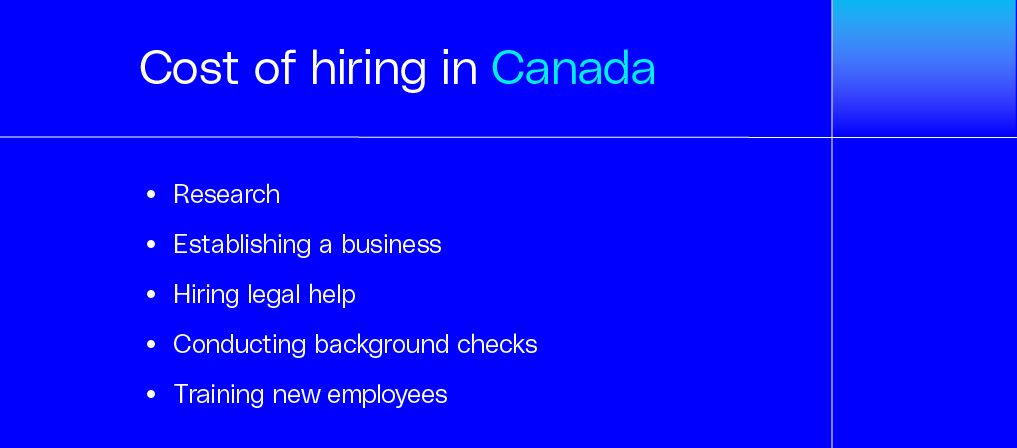
Whether you’re hiring one employee or an entire team in Canada, expenses are inevitable. Budget for the following:
-
Research: Determine where in Canada you want to establish your business, and research the legalities that relate to employment practices there, as well as any requirements for your industry.
-
Establishing your business: Unless you work with an Employer of Record (EOR) , you’ll have to set up a branch or subsidiary in Canada and cover the related costs.
-
Posting the job ad: Posting your job ad may also cost you. However, Canada has a public job board called Job Bank where you can post job ads for free.
-
Legal checks: Background checks or verifying an applicant’s legal right to work can add to your hiring costs.
-
Training: Hiring a new employee isn’t the end of your hiring costs. The next step is to invest in training to help your new hire become productive faster.
According to G-P Verified Sources from Gia , the total annual employer burden rate in Canada, which includes costs triggered on top of salaries, is between 7% and 12%. Rates depend on the employee’s earnings, province of employment, and the industry.
What does a company need to hire employees in Canada?
Make sure you cover these essentials before expanding your team in Canada:
-
A branch or subsidiary: Unless you’re hiring independent contractors or working with an EOR, you need a legal business entity in Canada. There are two main options: a branch or a subsidiary .
-
Incorporation: To incorporate a business in Canada, you need articles of incorporation either through an individual province/territory or through the federal government. Businesses based outside of Canada must register as an extra-provincial corporation in any province where they plan to do business.
-
Payroll deductions account: You must have a business number (BN) and use your BN to create a payroll deductions program account with the Canada Revenue Agency (CRA). This account is used to remit employees’ deductions to the CRA.
-
Permits and licenses: Depending on your industry, you may need specialized permits or licenses. The Canadian government has an online tool where you can check to see what permits and licenses you need.
-
Workers’ compensation insurance: Most businesses also need workers’ compensation insurance. To get this coverage, register your business with the Workers’ Compensation Board (WCB) in the relevant province. Premiums will be based on your industry.
Use G-P EOR to hire full-time employees in Canada without setting up your own entity. Build your team in Canada at a lower cost and with peace of mind that you’re doing so compliantly.
Steps to hiring in Canada
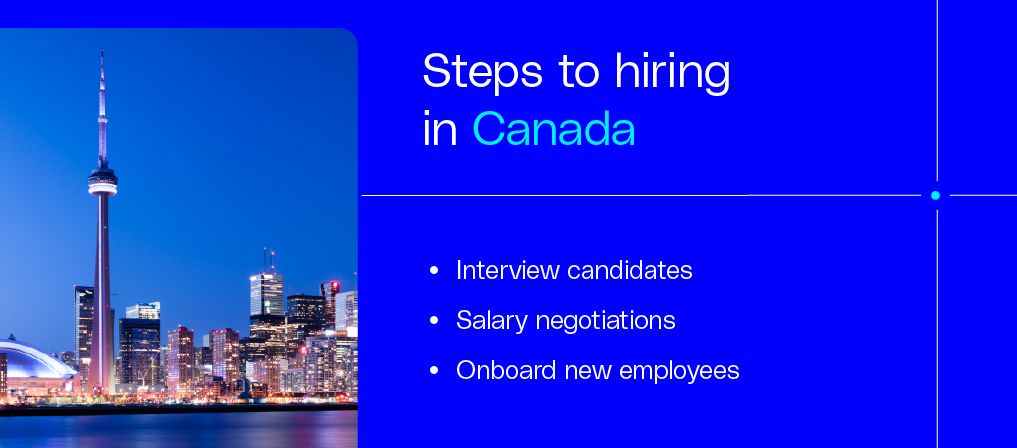
There are five basic steps for hiring in Canada. We’ve summarized these steps below, along with tips based on local customs and requirements that govern hiring practices in Canada.
1. Post a job ad
The first step is to determine the skills you’re looking for. Compile this information into a detailed job ad. You may want to publish the ad in both French and English, depending on the province.
When listing any educational requirements, remember that in Canada, the term “college” refers to schools that teach specific trades or career skills and grant diplomas, while “university” refers to degree-granting institutions.
2. Evaluate applications
Once the applications come in, decide which candidates will move on to the interview stage. You can use software or an agency to help with the initial screening process, or you can have your team complete this task internally.
3. Interview candidates
Next, interview candidates who made it onto your shortlist. You can conduct interviews virtually or in person if you have a branch or subsidiary set up. Phone or video interviews are especially helpful if you’re hiring remote employees in Canada and want to avoid traveling there.
If you’re scheduling a virtual interview, consider the time difference. Canada has several time zones that span a difference of four hours . Schedule your interview during overlapping business hours between your country and the candidate’s province.
4. Follow up and draft a contract
Once you’ve chosen the ideal candidate, follow up and formally offer them the job. It’s common for employees in Canada to negotiate their salary. You should also create a contract at this stage.
In Canada, you can legally form an employment contract verbally. However, having a contract in writing is a good way to confirm both parties agree to the employment terms. G-P EOR has an Employment Contact Generator to help you draft compliant employment contracts that meet all legal requirements and best practices in Canada.
5. Onboard your new hire
Now you can onboard your new hire . Request your new hire’s Social Insurance Number (SIN) card within three days of their start date, and record the information on it. Employees must fill out the Form TD1, Personal Tax Credits Return, from the federal government and from their province, so you know how much tax should be taken out of their paychecks. In Quebec, the provincial form is known as Form TP1015.3-V.
Onboard your team members in Canada in minutes with G-P EOR . We’ll handle the legal and administrative tasks, so you can start working faster. Simple, self-guided workflows ensure a smooth process for you and your new hires.
Hiring contractors in Canada
Working with independent contractors in Canada can be a cost-effective way to test the market and build a presence without the commitment of full-time employees. Contractors based in Canada understand local consumer behavior, rules, and business practices. They’ll be ready to start working quickly with their own equipment and established work processes.
Hiring contractors allows you to easily adjust your workforce based on your business needs, without the complexities and costs of employment.
Before you enter an agreement with an independent contractor in Canada, consider the following:
1. Employees vs. independent contractors
In Canada, employers hire employees to do work and, in return, pay them a regular salary or wage. Independent contractors provide services. Unlike employees, contractors set their schedules, use their own equipment, and work on specific projects, rather than having an ongoing role.
2. Penalties for misclassification
Classifying someone as a contractor when they’re not can lead to severe penalties. If misclassification occurs, you may need to:
-
Pay back taxes, including unpaid income tax deductions, Canada Pension Plan (CPP) contributions, and Employment Insurance (EI) premiums.
-
Cover the cost of unpaid wages, benefits, and protections under labor standards to misclassified employees.
-
Face audits and investigations from the Canada Revenue Agency (CRA).
3. How to pay contractors in Canada
G-P Contractor
™ takes away the messy, time-consuming process of hiring and paying international contractors. You can create and issue contracts and pay contractors with just a few clicks, all while ensuring a compliant process.
Hire employees and contractors with G-P
Our SaaS and AI-powered products – EOR , Contractor , and Gia – help companies of all sizes build and manage global teams.
With more than a decade of experience, the largest team of HR, legal, and compliance experts, and a global proprietary knowledge base, G-P is the recognized leader in global employment .
Make your expansion to Canada easier with G-P. Contact us or book a demo today.
